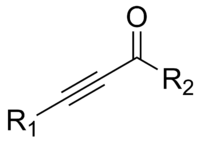
In organic chemistry, an ynone is an organic compound containing a ketone (>C=O) functional group and a C≡C triple bond. Many ynones are α,β-ynones, where the carbonyl and alkyne groups are conjugated. Capillin is a naturally occurring example. Some ynones are not conjugated.
Synthesis of α,β-ynones[edit]
One method for synthesizing ynones is the acyl substitution reaction of an alkynyldimethylaluminum with an acyl chloride. An alkynyldimethylaluminum compound is the reaction product of trimethylaluminum and a terminal alkyne.[1]

An alternative is the direct coupling of an acyl chloride with a terminal alkyne, using a copper-based nanocatalyst:[2]

Other methods utilize an oxidative cleavage of an aldehyde, followed by reaction with a hypervalent alkynyl iodide, using a gold catalyst.[3]
An alternative but longer synthetic method involves the reaction of an alkynyllithium compound with an aldehyde. The reaction produces a secondary alcohol that then can be oxidized via the Swern oxidation.
Synthesis of β,γ- and γ,δ-ynones[edit]
Terminal alkynes add across α,β-unsaturated ketones in the presence of palladium catalysts. The reaction affords γ,δ-ynones.[4] Terminal alkynes add across epoxides to given yneols, which can be oxidized to give β,γ-ynones.[5]
Further reading[edit]
- Bis-ynones can undergo an intramolecular cycloaddition to form furan derivatives.[6]
See also[edit]
References[edit]
- ^ Wang, Baomin; Bonin, Martine; Micouin, Laurent (June 22, 2005). "A Straightforward Synthesis of Ynones by Reaction of Dimethylalkynylaluminum Reagents with Acid Chlorides". J. Org. Chem. 70 (15): 6126–6128. doi:10.1021/jo050760y. PMID 16018717.
- ^ Weijiang, Sun; Wang, Yan; Wua, Xuan; Yao, Xiaoquan (2013). "Palladium-, ligand-, and solvent-free synthesis of ynones by the coupling of acyl chlorides and terminal alkynes in the presence of a reusable copper nanoparticle catalyst". Green Chemistry. 15 (9): 2356–2360. doi:10.1039/c3gc40980e.
- ^ Wang, Zhaofeng; Li, Li; Yong, Huang (August 18, 2014). "A General Synthesis of Ynones from Aldehydes via Oxidative C–C bond Cleavage under Aerobic Conditions". J. Am. Chem. Soc. 136 (35): 12233–12236. doi:10.1021/ja506352b. PMID 25133731.
- ^ Feng Zhou, Liang Chen, Chao-Jun Li (2014). "Palladium-catalyzed 1,4-Addition of Terminal Alkynes to Conjugated Enones". Organic Syntheses. 91: 72. doi:10.15227/orgsyn.091.0072.
{{cite journal}}: CS1 maint: multiple names: authors list (link) - ^ Adam Sniady, Marco S. Morreale, Roman Dembinski (2007). "Electrophilic Cyclization with N-Iodosuccinimide: Preparation of 5-(4-Bromophenyl)-3-Iodo-2-(4-Methyl-Phenyl)Furan". Organic Syntheses. 84: 199. doi:10.15227/orgsyn.084.0199.
{{cite journal}}: CS1 maint: multiple names: authors list (link) - ^ Wills, M.S.B.; Danheiser, R.L. (August 28, 1998). "Intramolecular [4 + 2] Cycloaddition Reactions of Conjugated Ynones. Formation of Polycyclic Furans via the Generation and Rearrangement of Strained Heterocyclic Allenes". J. Am. Chem. Soc. 120 (36): 9378–9379. doi:10.1021/ja9819209.
External links[edit]
 Media related to Ynones at Wikimedia Commons
Media related to Ynones at Wikimedia Commons
Well, that’s interesting to know that Psilotum nudum are known as whisk ferns. Psilotum nudum is the commoner species of the two. While the P. flaccidum is a rare species and is found in the tropical islands. Both the species are usually epiphytic in habit and grow upon tree ferns. These species may also be terrestrial and grow in humus or in the crevices of the rocks.
View the detailed Guide of Psilotum nudum: Detailed Study Of Psilotum Nudum (Whisk Fern), Classification, Anatomy, Reproduction